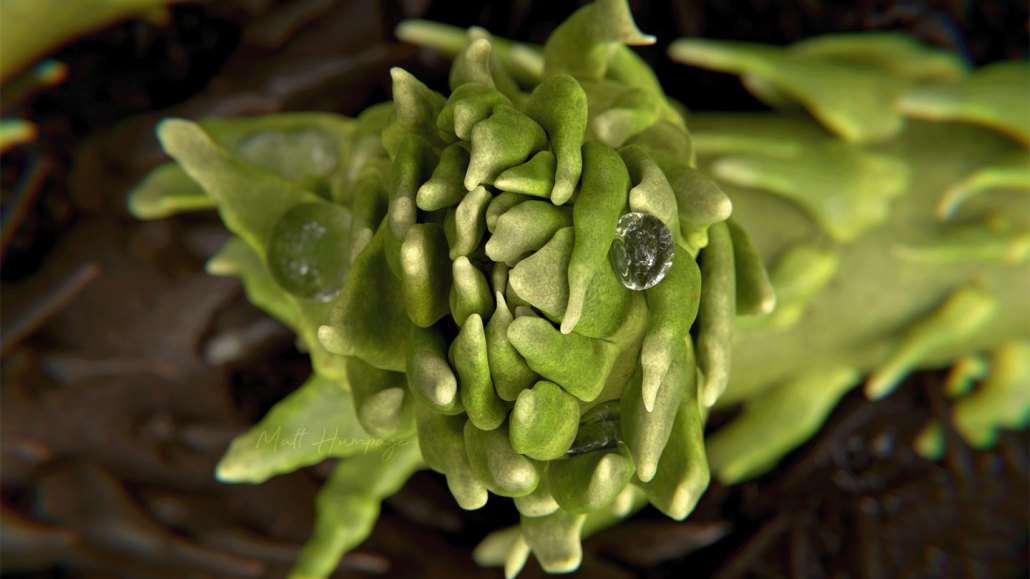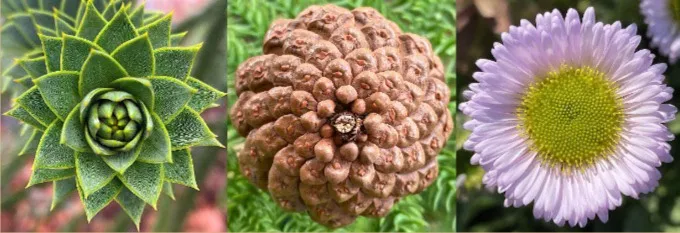
Digital reconstructions (one shown) of Asteroxylon mackiei plants are providing new insights into the evolution of leaf patterns.
Matt Humpage, Northern Rogue Studios
An unusual arrangement of leaves in a 407-million-year-old fossilized plant is complicating scientists’ understanding of plant evolution.
Most land plants living today have spiral patterns involving the famous Fibonacci sequence of numbers. Because the spirals are so common, scientists have thought that the patterns must have evolved in some of the earliest land plants. But the leaves of the ancient plant, a member of one of the first plant groups known to have developed leaves, were arranged in spirals that can’t be described by Fibonacci numbers, researchers report in the June 16 Science.
The study “helps us to understand how [the] diversity of plants has been generated,” says botanist Barbara Ambrose, the director of laboratory research at the New York Botanical Garden in New York City, who was not involved in the research.
In the Fibonacci sequence, each number is the sum of the two previous ones: 1, 1, 2, 3, 5, 8, 13 and so on. Examples of spirals in plants that involve Fibonacci numbers can be seen in the arrangement of the leaves of some succulents, the bracts of a pinecone and the seeds of a sunflower, among many other plants (SN: 8/27/02).
In plants with spiraling patterns of leaves, all the leaves can be described by a set of curved lines that spiral clockwise out from the center as well as by a set of curved lines that spiral counterclockwise. If the numbers of clockwise and counterclockwise curves are both numbers found in the Fibonacci sequence, it’s known as Fibonacci spiraling.
Scientists aren’t sure why most modern plants adopt Fibonacci spiraling, but it might help maximize the amount of space between leaves or other plant parts (SN: 7/21/07). The patterns could also arise from the distribution of auxins, a type of plant growth hormone.

In the new study, Sandy Hetherington, a paleobotanist at the University of Edinburgh, and colleagues studied fossils of the extinct Asteroxylon mackiei, a member of a group of plants called lycopods that also includes modern club mosses.
The fossils were obtained from the Rhynie chert, a roughly 400-million-year-old deposit of sedimentary rock in Aberdeenshire, Scotland, that contains exceptionally well-preserved fossils of some of the first land plants. In 1969, researchers collected hundreds of cross-sectional images of A. mackiei fossils and the surrounding rock. Hetherington’s team digitally reconstructed the cross sections into 3-D representations of the original plants.
Two of the four reconstructed plants exhibited non-Fibonacci spiraling in their leaf arrangements. Both plants had eight counterclockwise spirals (a Fibonacci number). But one had seven clockwise spirals and the other had nine, neither of which is a Fibonacci number.
The leaves on the other two plants didn’t grow in spirals at all — instead, they grew in a series of rings stacked along the stem.
“Given the prevalence of Fibonacci spirals today and in the later fossil records of plants, we definitely expected Fibonacci spirals,” says study coauthor Holly-Anne Turner, a paleontologist now at University College Cork in Ireland. The A. mackiei fossils predate the next-earliest lycopod fossils that show non-Fibonacci spiraling by almost 50 million years.
Lycopod leaves evolved separately from leaves in other types of plants, but some modern lycopods do exhibit Fibonacci spiraling. That suggests the spiraling patterns may have evolved separately in different lineages of plants, says Peter Crane, a botanist and president of the Oak Spring Garden Foundation in Upperville, Va., who was not involved in the study.
A. mackiei is just one species, Ambrose notes. Though the fossil record is patchy, reconstructing other early plants could offer more clues to how these spirals evolve in nature.
New computing technology also means that it’s worth revisiting fossils that had been analyzed by hand decades ago, Turner says. With the amount of information and detail that can be collected from computer simulations, “you could find something really great.”






